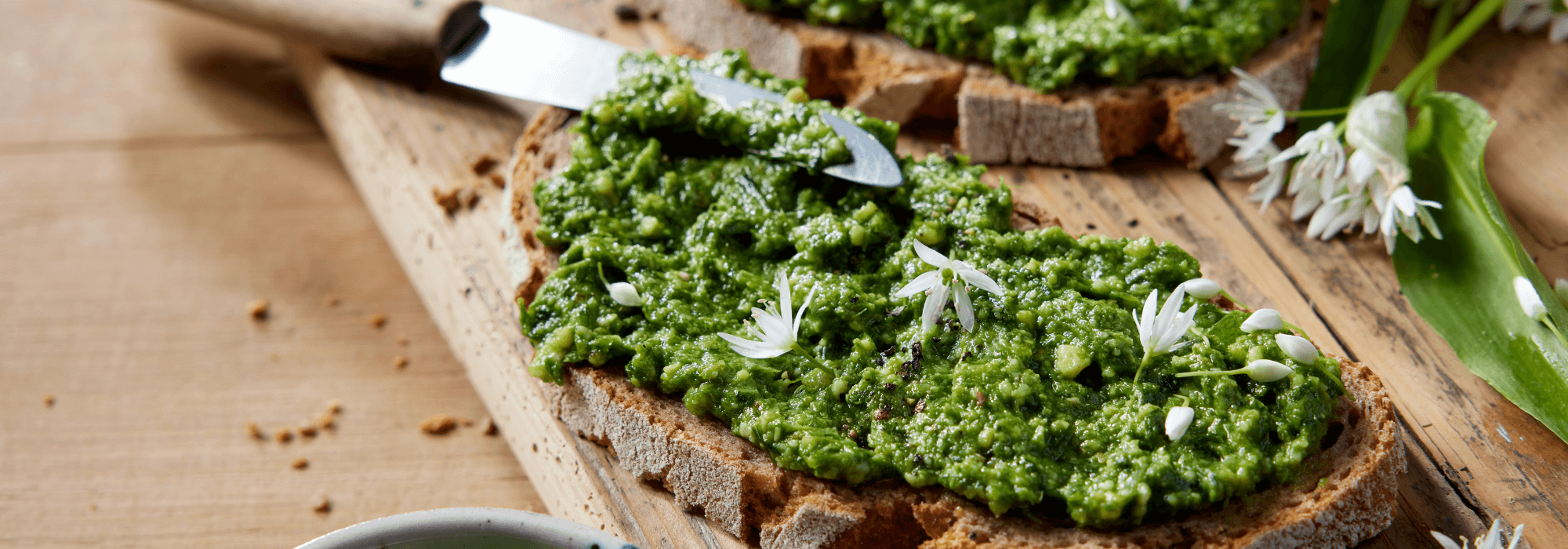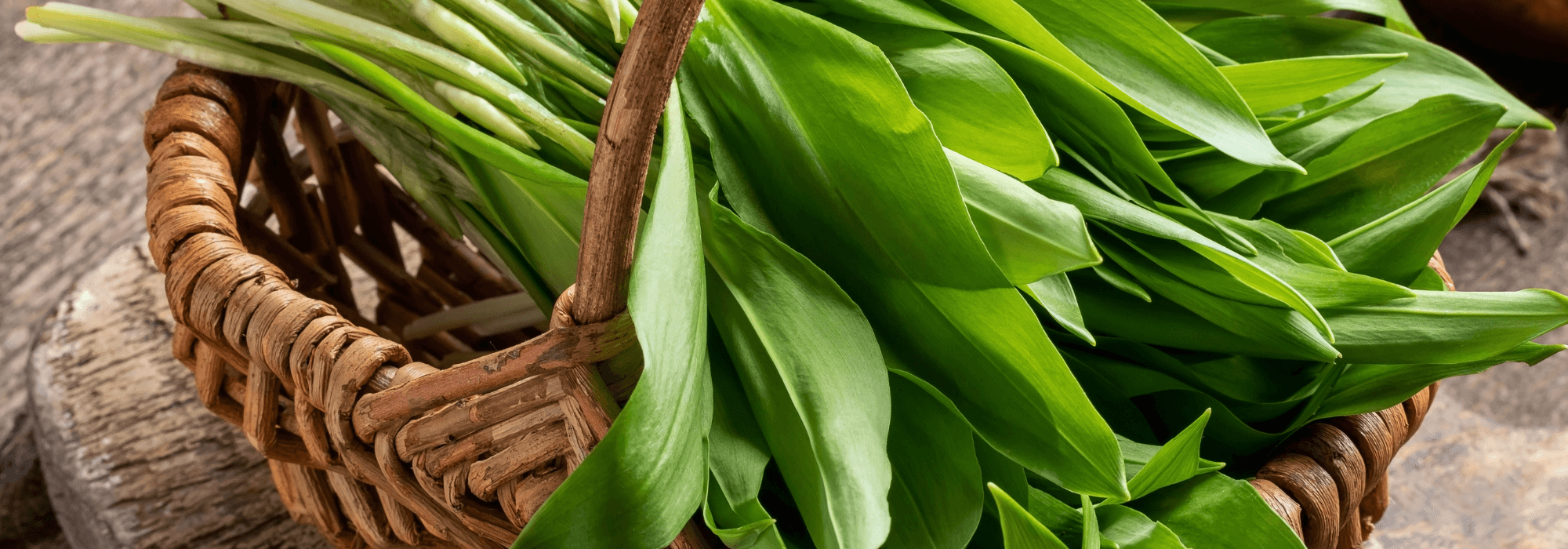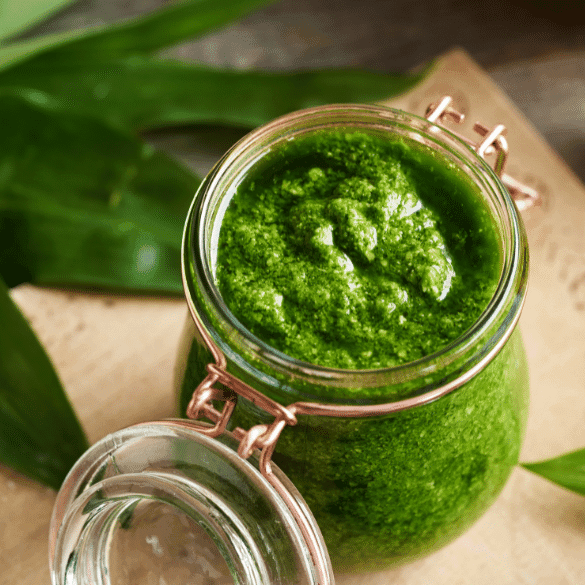Wild Garlic: Spring’s Superfood
Boost your immune system, digestion and heart health
Wild garlic is one of nature’s first signs that spring has arrived. Known scientifically as Allium ursinum and often called ramsons in the UK or bear’s garlic in the US, this vibrant, perennial plant offers a host of culinary and medicinal benefits.
Found in shaded woodlands and along stream banks, it’s a fantastic choice for beginner foragers.
Discover the many health benefits of wild garlic, how to forage for it safely, and a simple yet delicious wild garlic pesto recipe to boost your health.

Bold yet balanced flavour
Wild garlic has a robust garlicky taste with delicate onion-like undertones. While it carries a distinctive garlic scent, it’s milder than a clove of garlic or onion. The tender leaves and unopened flower buds, harvested in early spring, add a fresh and vibrant flavour to dishes. Use the bulbs whole or sliced in soups and salads, and toss the leaves into sauces, sandwiches, omelettes, pasta or risottos. Anywhere you’d use onions, leeks or garlic, wild garlic makes a great alternative.
Potent health benefits of wild garlic
Beyond its culinary uses, wild garlic has long been valued for its medicinal properties. It’s packed with antimicrobial, anti-inflammatory and immune-boosting compounds that support overall well-being.
- Rich in allicin: When crushed or chopped, wild garlic releases allicin, a powerful compound that support immune function and helps protect against infections, parasites and fungi.
- Anti-inflammatory properties: The diallyl sulphides in wild garlic can help ease symptoms of arthritis, asthma and inflammatory bowel disease.
- Supports heart health, digestion and detoxification: Wild garlic’s sulphur compounds help regulate blood pressure, while also aiding digestion and the body’s natural detoxification processes.
For these reasons, wild garlic is often dried for teas, infused into tinctures, or blended into salves for skin ailments and joint pain.
Got a health issue you want to resolve? Ready to take charge of your family’s health or explore a career change?
Where to find wild garlic
Wild garlic has distinctive spear-shaped leaves with a smooth texture and clusters of star-shaped white flowers when in bloom. When not flowering, it can be identified by its elongated small bulbs with tiny white tips. The most reliable way to confirm its identity is by crushing a leaf – if it smells strongly of garlic, you’ve found the right plant.
However, there are a few toxic lookalikes to be aware of:
- Lily of the valley (Convallaria majalis) and autumn crocus (Colchicum autumnale) – Both lack the garlic scent and have different leaf shapes.
- Lords and ladies (Arum maculatum) – This toxic plant doesn’t resemble wild garlic but grows in similar habitats, making it easy to accidentally pick.
Key tip: Always inspect each leaf and bulb carefully before adding it to your foraging basket to ensure you’re not collecting toxic plants.

Safe and sustainable foraging
Foraging is a rewarding experience, but responsible practices are essential:
- Protect your skin with gloves to prevent reactions from other plants. Be prepared and carry a small first aid kit for minor scrapes or insect bites.
- Harvest responsibly by picking only young, fresh leaves, avoiding wilted or contaminated plants.
- Avoid over-harvesting and only take what you need (no more than 10%) to preserve local ecosystems.
- Choose clean areas and never forage near roadsides, industrial sites or areas with pesticide runoff.
Wild garlic pesto recipe
A simple, flavour-packed way to enjoy wild garlic is as a pesto!
Ingredients
- 100g wild garlic leaves, washed and blanched
- 50g toasted pine nuts or walnuts
- 100ml organic extra-virgin olive oil
- Juice of half a lemon
- Sea salt or Himalayan salt and freshly ground black pepper to taste
Method
- Blend the wild garlic leaves, toasted nuts and lemon juice in a food processor. Pulse until coarsely chopped.
- With the processor running, slowly drizzle in the olive oil until smooth, and season with salt and pepper to taste.
- Transfer to a clean jar and refrigerate for up to one week.
- Serve with pasta, spread on bread, or as a topping for salad or vegetables.

One of nature’s treasures
For those who grow their own food, each season requires careful planning and effort. But wild garlic is a reminder that nature provides, even without cultivation. By respecting our environment and foraging responsibly, we can enjoy this nutritious and flavoursome plant every spring. It’s easy to identify, abundant and a great addition to any kitchen.
Want to deepen your knowledge of nature’s edible gifts?
Explore the world of medicinal plants with a CNM Herbal Medicine courses:

